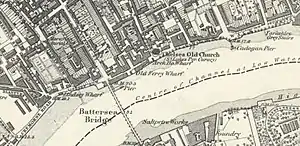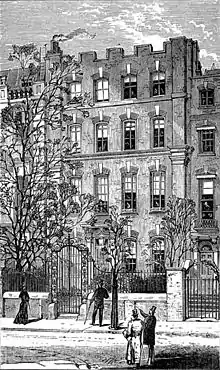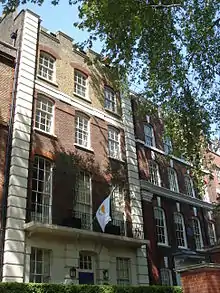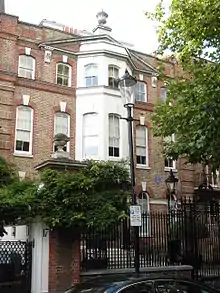Cheyne Walk
Cheyne Walk is a historic road, in Chelsea, London, in the Royal Borough of Kensington and Chelsea. It runs parallel with the River Thames. Before the construction of the Chelsea Embankment reduced the width of the river, it fronted the river along its whole length.

Location
At its western end, Cheyne Walk meets Cremorne Road end-on at the junction with Lots Road.[1] The Walk runs alongside the River Thames until Battersea Bridge where, for a short distance, it is replaced by Chelsea Embankment with part of its former alignment being occupied by Ropers Gardens. East of Old Church Street and Chelsea Old Church, the Walk runs along the north side of Albert Bridge Gardens and Chelsea Embankment Gardens parallel with Chelsea Embankment. At the north end of Albert Bridge, the Walk merges with Chelsea Embankment. The Walk ends at Royal Hospital Road.


At the western end between Lots Road and Battersea Bridge is a collection of residential houseboats that have been in situ since the 1930s. At the eastern end is the Chelsea Physic Garden with its cedars. It marks the boundary of the, now withdrawn, extended London Congestion Charge Zone. The section west of Battersea Bridge forms part of the A3220 road.
History

Cheyne Walk takes its name from William Cheyne, Viscount Newhaven who owned the manor of Chelsea until 1712.[2] Most of the houses were built in the early 18th century. Before the construction in the 19th century of the busy Chelsea Embankment, which now runs in front of it, the houses fronted the River Thames. The most prominent building is Carlyle Mansions. Chelsea Old Church dates from 1157 and Crosby Hall is a reconstructed medieval merchant's house relocated from the City of London in 1910.
In 1951, the Metropolitan Borough of Chelsea planned to construct a new river wall straightening the river bank west of Battersea Bridge. On the reclaimed land behind the wall a new arterial road and public gardens was to be constructed. Cheyne Walk was to remain unchanged to the north of the new public gardens. The works would have reduced the foreshore and required the removal of the house boat births.[3] The works did not take place. In the 1960s, plans for the Greater London Council's London Motorway Box project would have seen the West Cross Route, a motorway standard elevated road, constructed from Battersea to Harlesden through Earl's Court. A spur road would have been constructed from the motorway to the junction of Cheyne Walk and Lots Road.[4] The plans were abandoned because of the cost and opposition from local communities.
In 1972, number 96 Cheyne Walk, the then home of Philip Woodfield, a British civil servant, was the site of a top secret meeting between the British government and the leadership of the Provisional IRA aimed at ending the violence in Northern Ireland. The talks were inconclusive and the violence soon started again.
Notable residents
Many famous people have lived (and continue to live) in the Walk:




No. 1:
- Samuel Prout Newcombe (b. 1824) entrepreneur, leased the property from the ground landlord, the Earl Cadogan,[5] in 1891 shortly after it had been rebuilt. Newcombe had made his money in the 1850s from 'The London School of Photography', a photographic portrait studio that soon had branches across London and beyond, exploiting the public's appetite for carte de visite portraits. His daughter Bertha Newcombe (1857-1947) , who lived in the house until her father's death in 1912, was an artist, illustrator and suffragist. She had a relationship with George Bernard Shaw, who sat for a portrait in her studio within the house.
No.2:
- John Barrymore American actor, lived for a short time at No.2, on the corner with Flood Street.
- Vera Brittain, novelist and pacifist, and her husband, George Catlin, lived at number 2 before and during the Second World War.[6]
No.3:
- Admiral William Henry Smyth, and later Keith Richards, lived at number 3, which in 1945 became a National Trust property housing the Benton Fletcher collection of keyboard instruments.
No.4:
- George Eliot spent the last three weeks of her life at number 4.
- William Sandys Wright Vaux, antiquarian.
- William Dyce, Scottish painter and arts tutor.
- Daniel Maclise, painter.
- Michael Bloomberg, the former mayor of New York City, acquired number 4 in 2015.
No.5:
- The miser John Camden Neild lived at number 5.
- Also Howard Frank, English estate agent and co-founder of the Knight Frank estate agent chain.
No.6:
- Sir Arthur Sullivan English composer, attended a boarding school at number 6, in 1854.
- David Lloyd George lived at number 10.[7]
- Also Archibald Sinclair, 1st Viscount Thurso British Liberal politician, Secretary of State for War during World War II.
- Gerald Scarfe now lives there.
- The house has a plaque to commemorate Margaret Damer Dawson who was an early head of the women's Police service.[8]
No.11:
- Sir George Scott Robertson, Colonial Administrator and traveller in Afghanistan, lived at number 11, as did Sir Colin Scott-Moncrieff, British civil engineer, most notably in colonial Egypt.
No. 12:
- Sir John Scott Lillie, JP, decorated Peninsular War veteran, Deputy Lieutenant of Middlesex, inventor and political activist lived at no. 12, (previously, no. 13) Cheyne Walk and added a floor to it. The building was demolished in 1887, but elements from it were later used in the reconstruction of 1 Cheyne Walk.[9]
No.13:
- Ralph Vaughan Williams lived at number 13 from 1905 to 1928. There he wrote works including his first three symphonies, the Fantasia on a Theme by Thomas Tallis, The Lark Ascending, and Hugh the Drover.
No.14:
- Bertrand Russell lived at number 14 in 1902.[10]
No.15:
- The landscape painter Cecil Gordon Lawson lived at number 15 (a number of his works still hang there) as did the engraver Henry Thomas Ryall, 18th century Admiral Sir John Balchen, the Allason family, well known for their political and literary influence and the Baron and Baroness Courtney of Penwith.
- also Hester Dowden, English spiritualist.
No.16:
- Dante Gabriel Rossetti lived at number 16 (where he was banned from keeping peacocks due to the noise) from 1862 to 1882.[11]
- Hall Caine, novelist, as Rossetti's housemate.[12]
- Frederick Sandys, painter, as Rossetti's housemate 1866–67
- also Algernon Charles Swinburne.
- also Florence Kate Upton.English illustrator, creator of the Golliwog character.
- also John Paul Getty II lived here from the late 1970s to the early 1990s.[13]
- also Jacques Blumenthal, German pianist and composer
No.17:
- Thomas Attwood (composer) (1765–1838) lived at No 17 for some years up to his death in 1838. He was organist at St Paul's Cathedral from 1796, and of the Chapel Royal from 1836. He was a pupil of Mozart. Thomas Attwood is buried in the crypt of St Paul's underneath the organ.
No.18:
- Number 18 was renowned for being the home of the curious museum (knackatory) and tavern known as Don Saltero's Coffee House. The proprietor was James Salter, who was for many years the servant of Sir Hans Sloane.[7]
- Sir Hans Sloane's manor house, demolished in 1760, stood at numbers 19–26.
No.19:
- No 19 was site of the horrific 1973 killing of elderly widow Isabella Griffith, by the serial killer Patrick Mackay.
No.21:
- James McNeill Whistler lived at numbers 21 (1890–92), 72 (? to his death there in 1903), 96 (1866–1878) and 101 (1863) at different times.[14]
- Also Edward Arthur Walton lived here.[15]
No.22:
- Dame Elizabeth Taylor English actress, rented this house during the 1982 West End run of her Broadway play, The Little Foxes.
No.27:
- Bram Stoker Irish theatre manager and novelist, author of Dracula, lived at No.27.[7]
No.37:
- Architect C. R. Ashbee lived at number 37 until 1917. He also designed 38 and 39.[16]
- Nicolaus Ludwig, Imperial Count von Zinzendorf und Pottendorf, and the Brethren of the Moravian Church renovated Lindsey House at numbers 99–100 in Cheyne Walk in the mid-18th century; it was for a number of years the headquarters of their worldwide missionary activity. Moravian Close nearby is still the London God's Acre, where many famous Moravians are buried.
No.41:
- James Clerk Maxwell lived at number 41 while lecturing at King's College London in the early 1860s. He used the iron railings outside his home in two experiments on electro-magnetic fields, much to the dismay of friends and foreigners.
- Mortimer Menpes, the watercolourist and etcher, shared a flat with Whistler.
No.42 Shrewsbury House:
- Guy Liddell, British Intelligence officer, lived in a flat in the present Shrewsbury House, No.42 Cheyne Walk.
No.48:
- Mick Jagger and Marianne Faithfull lived at number 48 in 1968.[17]
No.89:
- Charles Edward Mudie, English publisher and founder of Mudie's Lending Library, was born 1818 in Cheyne Walk; where his father owned a Circulating library, stationery and book binding business at No. 89.[18][19]
No.91:
- Artist Charles Conder lived at 91 Cheyne Walk, 1904–1906[20]
No.92 (Belle Vue):
- The chemist Charles Hatchett, the poet William Bell Scott, and the anatomist John Marshall lived at Belle Vue House, number 92.[21]
- Also novelist Ken Follett and his wife, the politician Barbara Follett (politician)
- Also Patrick Wall, Conservative MP
No. 96-101 (Lindsey House) (presently known as No. 100)
- No.93:
- Elizabeth Gaskell was born at number 93.
- No.96:
- Diana Mitford lived at number 96 with her first husband Bryan Guinness in 1932.[22]
- No.98:
- Sir Marc Brunel, who designed the Thames Tunnel, lived at number 98...
- as did his son Isambard Kingdom Brunel.
- No.100:
- Hugh Lane, art dealer, collector and founder of the Municipal Gallery of Modern Art lived at number 100 (Lindsey House) from 1909 until his death on the RMS Lusitania in 1915.[23]
No.104:
- Hilaire Belloc lived at number 104, as did the artist Walter Greaves
- John Tweed, sculptor and friend of Auguste Rodin, lived at number 108.
No.109:
- Sir Philip Steer lived at number 109.
No. 113
- Suffragette Isabella Potbury and her husband, the playwright and actor Charles Nicholas Spencer.
No.119:
- J. M. W. Turner died at number 119 in 1851.
- Rolling Stones musician Ronnie Wood also lived here.
No.120:
- Sylvia Pankhurst lived at number 120 after leaving university.
No.122:
- Peter Warlock, English composer, lived at number 122, in 1921
- Also Timothy Whidborne, English portrait painter
- George Melly. Jazz musician, lived in a flat sublet by Whidborne
- Carlyle Mansions
- Richard Addinsell, English composer, lived in flat 1.
- Gordon Harker, English actor, lived in flat 11.
- Edward Robey, lawyer in the Acid Bath Murders case of the serial killer John George Haigh, lived in flat 11.
- T. S. Eliot, American poet and writer, lived in flat 19.
- Shapur Kharegat, journalist, editor and former Asia Director of The Economist lived at flat 17.
- John Davy Hayward, theatre and literary critic, lived in flat 19.
- Henry James spent his last years and died here in flat 21.
- Erskine Childers lived in flat 20, with his family, and wrote his novel The Riddle of the Sands there as well. He also lived at 16 Cheyne Gardens for several years.
- Ian Fleming, novelist, Intelligence officer, creator of spy James Bond, lived in flat 24. He also lived briefly at number 122 Cheyne Walk
- W. Somerset Maugham, British novelist, lived in flat 27.
- Lionel Davidson lived at Carlyle Mansions from 1976 to 1984, where he wrote The Chelsea Murders, a CWA Gold Dagger winner.
- Sol Campbell has a six-storey, five bedroom house in Cheyne Walk, and an apartment in Carlyle Mansions.[24]
- Edith Cheesman, watercolour artist, lived at number 127 in 1911, since demolished and now covered by the World's End Estate, where The Clash frontman Joe Strummer lived.
- George Weidenfeld, publisher, who became Lord Weidenfeld of Chelsea, lived here from the 1960s until his death on 20 January 2016.
- George Best once had a flat there.
- Laurence Olivier and Jill Esmond lived there in the 1930s.
- Mary Sidney lived at Crosby Hall from 1609 to 1615.
- In July 1972, during a short-lived ceasefire, an IRA delegation that included Gerry Adams and Martin McGuinness held talks in a house in Cheyne Walk with a British government team led by Northern Ireland Secretary William Whitelaw.
- The Old Cheyneans – former pupils of Sloane Grammar School, Hortensia Road, Chelsea – take their name from the association with Cheyne Walk and Sir Hans Sloane who lived there.
- Colin Colahan, Australian painter and sculptor, lived in Cheyne Walk.
- Augustus Pugin, English architect, known for his work on the Palace of Westminster, lived briefly on Cheyne Walk in 1841.
- Susan Fleetwood, British actress, lived on Cheyne Walk. Her brother is Mick Fleetwood, a member of British rock group Fleetwood Mac. He was part of an earlier short lived band, the Cheynes, named after the street.
Fictional residents
- Sâr Dubnotal (1909-1910) owned a house in Cheyne Walk.
- Thomas Carnacki (1910-1912), a fictional occult detective created by English fantasy writer William Hope Hodgson, lived in a flat at 472 Cheyne Walk.
- Katharine Hilbery, the protagonist of Virginia Woolf's second novel, Night and Day (1919), lives on Cheyne Walk with her parents.
- In Nancy Mitford's novel The Pursuit of Love, (1945) the heroine Linda Radlett lives in a house on Cheyne Walk before and during the Second World War.
- The climax of The French Lieutenant's Woman (1969) by John Fowles is set at number 16, in the Rossetti household.
- In Iris Murdoch's A Word Child (1975), Gunnar Jopling and his second wife, Lady Kitty, lived here.
- In Roald Dahl's My Uncle Oswald (1979), the protagonist lives with his parents in Cheyne Walk at the start of the story.
- In Jeffrey Archer's 1984 British political novel First Among Equals, the MP Richard Fraser lived in Cheyne Walk.
- Margaret Prior, the protagonist of Sarah Waters' Affinity (1999), lives on Cheyne Walk.
- Richard Bolitho's mistress Lady Catherine Somervell kept a house on Cheyne Walk as mentioned in Alexander Kent's novel, The Darkening Sea (1993).
- In Timothy Findley's Pilgrim (2000), the eponymous main character is a former resident of Cheyne Walk.
- In Stormbreaker (2000), Alex Rider directs his cab to his home in Cheyne Walk, London.
- In Daniel Silva's The Defector (2009), the Russian billionaire Viktor Orlov lives at number 43.
- In Cassandra Clare's The Infernal Devices series, werewolf Woolsey Scott lives at No. 16.
- In Elizabeth George's Inspector Lynley series, Simon and Deborah St James live and work on Cheyne Walk.
- Sean Dillon, a recurring character from author Jack Higgins, has a home in Cheyne Walk.
- Lady Celia Lytton and members of her family live in a house on Cheyne Walk for more than half a century in Penny Vincenzi's trilogy, The Spoils of Time.
References and sources
- References
- "OS Maps Online". Ordnance Survey. Retrieved 7 October 2017.
- "The Gentleman's Magazine". google.com. 1810.
- "What is to Happen to Chelsea's Famous Cheyne Walk River Front". Illustrated London News (5855): 23. 7 July 1951. Retrieved 8 October 2017.
- "Ringway 1 West Cross Route". Pathetic Motorways. Retrieved 8 October 2017.
- Survey of London, Vol. 2: Chelsea, Pt I (London County Council, 1909).
- "Did Haig have a London residence - Great War Forum". greatwarforum.org. Retrieved 24 September 2018.
- "Chelsea Walk - Cheyne Walk 1-30". Rbkc.gov.uk. 18 May 2006. Retrieved 6 July 2017.
- Damer Dawson's plaque Archived 25 July 2014 at the Wayback Machine, LondonRemembers.com, retrieved 20 July 2014
- "Cheyne Walk: No. 1". British-history.ac.uk. Retrieved 6 July 2017.
- Frege, Gottlob. 1980. Philosophical and Mathematical Correspondence. Oxford: Blackwell. pp. 147–155. ISBN 0 631 19620 X
- Pamela Todd, Pre-Raphaelites at Home, Watson-Giptill Publications, ISBN 0-8230-4285-5
- Caine, Hall (1882). Recollections of Dante Gabriel Rossetti. London: Elliot Stock. p. 114.
- Obituary, The Independent, 14 June 2001
- "No. 72, Cheyne Walk". british-history.ac.uk.
- "Manuscripts - Collections relating to Edward Arthur Walton". Archived from the original on 20 November 2011. Retrieved 2 February 2010.
- Gere, Charlotte, & Michael Whiteway. (1993) Nineteenth-century Design: From Pugin to Mackintosh. London: Weidenfeld & Nicolson. p. 253. ISBN 0297830686
- Faithfull, Marianne (1995). Faithfull. Penguin. p. 223. ISBN 0-14-024653-3.
- London and Country Directory, 1811
- Article titled "Mudie's" in the 'London Echo'
- "Charles Conder" by Ann Galbally and Barry Pearce, Art Gallery of NSW., 2003, p.200, ISBN 978-0-7347-6343-3
- Godfrey, Walter Hindes (1913). "Belle Vue House, No. 92, Cheyne Walk". Survey of London, vol. 4: Chelsea, pt II. British History Online. pp. 31–32. Retrieved 18 April 2012.
- Courcy, Anne de (26 October 2004). Diana Mosley. ISBN 9780060565336.
- O'Byrne, Robert Hugh Lane 1875–1915. Lilliput Press, 2000, p. 118.
- Riley-Smith, Ben (30 September 2014). "Sol Campbell attacks Labour's mansion tax in scathing series of tweets". The Daily Telegraph. Retrieved 1 October 2014.
- Sources
- Stourton, James (2012). Great Houses of London (Hardback). London: Frances Lincoln. ISBN 978-0-7112-3366-9.
External links
![]() Media related to Cheyne Walk at Wikimedia Commons
Media related to Cheyne Walk at Wikimedia Commons